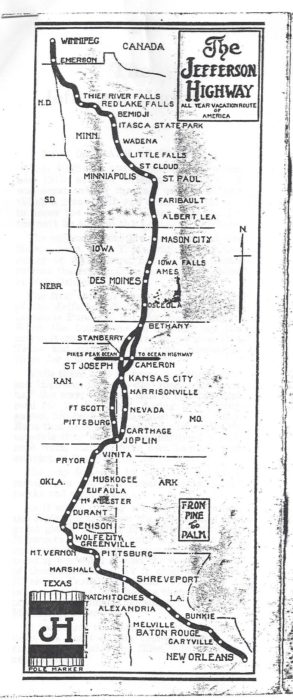
(From JeffersonHighway.org.) This 22nd Jefferson Highway tourist maps show the route from Winnipeg in Canada to New Orleans, Louisiana. Much discussion and controversy went into the final route. J. Riley Green of Hunt County, Texas, was instrumental in seeing that Northeast Texas was included.
John Riley Green, better known as J. Riley, found himself stuck in the mud on the way to Greenville from Wolfe City one day in 1921. As a strong proponent of paved, he used the incident to promote his drive for more roads to help farmers transport cotton, corn, and livestock to markets. No local farmer came along to pull him out of the mud with a team of mules. Instead a fleet of trucks publicizing “Ship by Trucks” happened by and rescued the Good Roads Man.
Green saw the need for alternatives to the railroad system and the coming of the automobile. His interest in good roads came from several sources. All his life he was involved in agriculture, particularly livestock and cotton. He knew the dire need for reliable transportation to get produce to market in a timely manner. He experienced the decline in farm prices due to the continual increase in railroad fees.
Falling farm prices and increased rail fares created a struggle for the farmer to survive; often the loss of land altogether meant of life of tenancy. After 1900 one-third of all Southern farms were operated by tenants.
By the end of World War I trucks began to slowly replace railroads. But in the Blackland Prairies, the heavy clay soil was difficult to travel on in wet weather. Hence, J. Riley Green’s encounter with the Ship by Trucks demonstrated that highways were the future for farmers.
In 1921 J. Riley Green became involved with the Hunt County Chamber of Commerce. Through that group, he became interested in paving roads to outlying communities. Named to the Hunt County Road Board in 1921, he and three other men became overseers of roads from Greenville to Quinlan, to Caddo Mills, to Floyd, to Celeste, to Wolfe City, to Commerce, to Campbell, and to Lone Oak, all communities in Hunt County. The committee bought the equipment and materials, saw that the project was within budget and built some of the finest roads in Texas, given the condition of native soils.
One of the first transcontinental roads was the Jefferson Highway starting in Winnipeg, Canada, to New Orleans. Along the way it went through Denison, Wolfe City, and Greenville in Texas. J. Riley Green served on the board of directors of the highway. It was through his influence that the route bypassed parts of Arkansas and entered Texas at Denison. It left Texas near Marshall on the way to Shreveport. At one of the board meetings, Green announced a free campground at Wolfe City and special accommodations for tourists. The Wolfe City enterprise was the 34th such accommodations of the Jefferson Highway designed for automobile tourists.
When J. Riley Green died in June 1927, friends and colleagues from throughout the country eulogized him. The Honorable Morris B. Harrell of Greenville declared Green was “great for our nation and generation.” Certainly many rural residents agreed.
